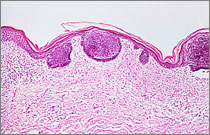Prostate cancer
| 2020 | |
|---|---|
¹ per 100,000 persons, age-standardised according to the old European standard population * calculated using the period method for 2019 / 2020 | |
| Men | |
| Incidence | 65,820 |
| Age-standardised incidence rate¹ | 97.4 |
| Deaths | 15,403 |
| Age-standardised mortality rate¹ | 18.6 |
| 5-year prevalence | 286,600 |
| 10-year prevalence | 490,500 |
| Relative 5-year survival rate* | 91 % |
| Relative 10-year survival rate* | 89 % |
The number of new cases of prostate cancer diagnosed in 2020 was around 65,820. After an increase at the beginning of the 2000s, the age-standardised disease rate has been declining slightly since 2011 and has been rather constant in recent years. A similar development can be observed in many other western industrialized nations and is probably due to prostate specific antigen (PSA) testing as a screening test: a long initial period of increasing use followed by a recent decline.

![]() Age-standardised incidence and mortality rates, ICD-10 C61, Germany 1999 – 2016/2017, projection (incidence) through 2020, per 100,000 (old European standard population)
Age-standardised incidence and mortality rates, ICD-10 C61, Germany 1999 – 2016/2017, projection (incidence) through 2020, per 100,000 (old European standard population)
In contrast to the incidence rate, the age-standardised mortality rate decreased continuously until 2007 and has remained fairly stable since then. Current incidence in Germany is similar to rates in other central European countries.
Prostate cancer rarely occurs before the age of 50: For a 35-year-old man, the risk of falling ill in the next 10 years is less than 0.1 percent, whereas that of a 75-year-old man is about 7 percent. The overall relative 5-year survival rate for prostate cancer is 91 percent. About two thirds of tumours are diagnosed at an early stage (UICC I/II).
Risk factors and early detection
The causes of prostate cancer and the factors influencing its course remain largely unknown. Age is an important risk factor. Men of black African origin develop prostate cancer more frequently than Europeans and white North Americans, while Asians are less often affected. Incidence of the disease among close relatives is a well-established risk factor. In addition, chronic inflammation of the prostate and sexually transmitted diseases appear to increase the risk of prostate cancer.
There is little evidence of lifestyle- or environment-related risk factors. However, maintaining a normal weight and getting sufficient exercise may reduce the risk of prostate cancer.
For men from the age of 45 years, the statutory early detection programme in Germany currently provides an annual check-up, the examination of the external genital organs and the palpation of the prostate and lymph nodes. PSA testing is not part of the statutory early detection program, as the net benefit of population-wide PSA screening has not yet been demonstrated beyond doubt.
Date: 21.03.2024






